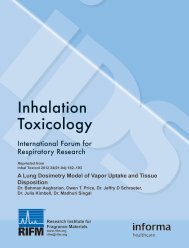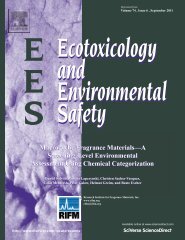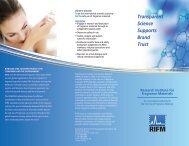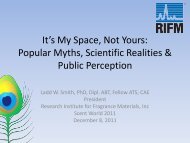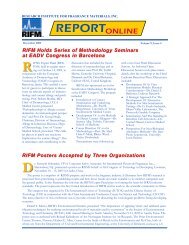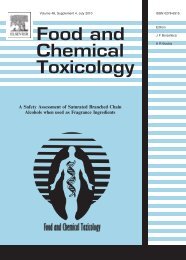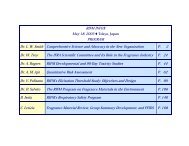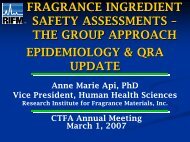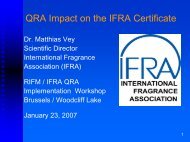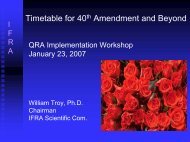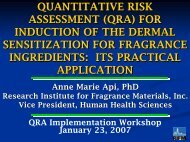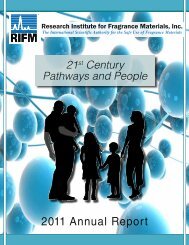here - Research Institute for Fragrance Materials
here - Research Institute for Fragrance Materials
here - Research Institute for Fragrance Materials
Create successful ePaper yourself
Turn your PDF publications into a flip-book with our unique Google optimized e-Paper software.
Skin Absorption Modeling:<br />
Practical Applications<br />
Valerie T. Politano, Ph.D.<br />
Human Health Scientist<br />
<strong>Research</strong> <strong>Institute</strong> <strong>for</strong> <strong>Fragrance</strong> <strong>Materials</strong>, Inc.<br />
Woodcliff Lake, NJ<br />
13 November 2007 American College of Toxicology
<strong>Research</strong> <strong>Institute</strong> <strong>for</strong> <strong>Fragrance</strong><br />
• RIFM VISION Statement<br />
<strong>Materials</strong>, Inc.<br />
• To be the International Scientific Authority <strong>for</strong> the Safe Use<br />
of <strong>Fragrance</strong> <strong>Materials</strong><br />
• RIFM MISSION Statement<br />
• Engage in research and evaluation of fragrance materials<br />
through an independent Expert Panel<br />
• Determine safety in use<br />
• Gather, analyze and publish scientific in<strong>for</strong>mation<br />
• Distribute scientific data and safety assessment judgments<br />
to RIFM members, industry associations and other<br />
interested parties<br />
• Maintain an active dialogue with official international<br />
agencies<br />
13 November 2007 American College of Toxicology 2
<strong>Research</strong> <strong>Institute</strong> <strong>for</strong> <strong>Fragrance</strong><br />
<strong>Materials</strong>, Inc.<br />
• Non-profit corporation, created in 1966<br />
• Membership open to all companies that<br />
manufacture, sell, distribute or engage in<br />
business related to the fragrance industry<br />
• Maintain database of greater than 4500<br />
fragrance and flavor ingredients<br />
• RIFM sponsored studies<br />
• Member company data<br />
• Scientific literature<br />
13 November 2007 American College of Toxicology 3
<strong>Research</strong> <strong>Institute</strong> <strong>for</strong> <strong>Fragrance</strong><br />
<strong>Materials</strong>, Inc.<br />
• RIFM's Panel of Experts (REXPAN)<br />
• Independent and international group of<br />
dermatologists, pathologists, environmental<br />
scientists and toxicologists<br />
• No commercial ties to fragrance industry<br />
• REXPAN advises RIFM on its strategic<br />
approach, reviews protocols and evaluates all<br />
scientific findings*<br />
• REXPAN's conclusions <strong>for</strong>m the basis <strong>for</strong> the<br />
Standards set by the International <strong>Fragrance</strong><br />
Association (IFRA)<br />
* Bickers et al. (2003) Reg. Toxicol. Pharmacol. 37:218-273.<br />
13 November 2007 American College of Toxicology 4
Group Approach<br />
• Used by many groups <strong>for</strong> quite some time<br />
• OECD process<br />
• US EPA<br />
• Joint FAO/WHO Expert Committee on Food<br />
Additives (JECFA)<br />
• FEMA Expert Panel (flavors)<br />
• RIFM Expert Panel (fragrances)<br />
• Successful example in the OECD process<br />
• Solvents propyl acetate and butyl acetate<br />
• easily metabolized by esterases to the corresponding acid<br />
and alcohol, which are the ultimate active molecules<br />
13 November 2007 American College of Toxicology 5
Group Approach<br />
• Chemical structure helps to predict<br />
• Transdermal absorption<br />
• Metabolism<br />
• Disposition<br />
• Functional groups that can influence toxicity<br />
• Group safety evaluations can demonstrate<br />
that within a congeneric group similar<br />
biochemical fate and toxicological potential<br />
can be exhibited<br />
• It can be shown that the group is efficiently<br />
detoxified to yield the same or similar<br />
metabolites<br />
13 November 2007 American College of Toxicology 6
RIFM <strong>Fragrance</strong> Structure-<br />
Activity Group Approach<br />
• 88% fragrances are structurally simple<br />
• Low molecular weight<br />
• Predominantly semi-volatile substances<br />
• Consisting of carbon, hydrogen and oxygen<br />
• Majority can be assigned to several homologous groups<br />
of structurally-related related materials<br />
• ~ 2,100 chemically defined fragrance ingredients<br />
• 23 Structurally-related related groups (e.g. Acids, Acetals, , Alcohols)<br />
• > 150 Subgroups (e.g. Straight chain saturated, straight chain<br />
unsaturated etc.)<br />
• These structure-activity groups <strong>for</strong>m the basis of the<br />
REXPAN Group Summaries, which contain 20-30<br />
materials<br />
• Though a material is included in a single structure-activity group<br />
it may be part of several REXPAN summaries<br />
13 November 2007 American College of Toxicology 7
Ketones<br />
10%<br />
RIFM Groupings <strong>for</strong> <strong>Fragrance</strong><br />
Volume of Use<br />
Hydrocarbons<br />
4%<br />
Musks<br />
6%<br />
Aldehydes<br />
15%<br />
Other<br />
8%<br />
Ingredients<br />
Alcohols<br />
23%<br />
Esters<br />
34%<br />
Number of<br />
<strong>Materials</strong><br />
Esters<br />
33%<br />
Hydrocarbons<br />
4%<br />
Alcohols<br />
16%<br />
Aldehydes<br />
10%<br />
Musks<br />
0.3%<br />
Other<br />
26%<br />
Ketones<br />
12%<br />
13 November 2007 American College of Toxicology 8
RIFM Group Approach<br />
• Form basis <strong>for</strong> REXPAN Group Summaries<br />
• Can reasonably predict some degree of consistency<br />
of metabolism and toxicity<br />
• For most, it can be shown that the group is<br />
efficiently detoxified to yield the innocuous<br />
metabolites<br />
• Low systemic exposure levels (many below<br />
thresholds of toxicological concern)<br />
• Review existing in<strong>for</strong>mation <strong>for</strong> a group<br />
• May need to submit a fragrance ingredient to full<br />
toxicological testing OR<br />
• May be necessary to test one or more particular<br />
members of a group to obtain more robust data to<br />
solidify assessment of the class as a whole<br />
13 November 2007 American College of Toxicology 9
Group Summaries<br />
• Per<strong>for</strong>m safety evaluations on groups of<br />
structurally-related related fragrance materials<br />
• Systematic review of all human health and<br />
environmental data <strong>for</strong> the group<br />
• Review <strong>for</strong> data gaps, conduct studies if<br />
necessary<br />
• Conduct studies on high-volume material to<br />
support group<br />
• Published together in peer-reviewed reviewed scientific<br />
journal<br />
• Group Summary authored by REXPAN<br />
• <strong>Fragrance</strong> Material Review on each member of<br />
the group, authored by RIFM staff<br />
13 November 2007 American College of Toxicology 10
Skin Absorption<br />
• Major route of human exposure to fragrance<br />
materials occurs through skin contact<br />
• Exposures can vary widely with different<br />
product types, ranging from fine perfumes<br />
and lotions to household cleaners<br />
• In risk assessments, currently assume 100%<br />
absorption when no data exists<br />
• Conservative assumption<br />
• Few fragrance materials have data<br />
• Narrow margin of safety<br />
13 November 2007 American College of Toxicology 11
Skin Absorption<br />
• Several factors relevant to fragrance<br />
exposures, including but not limited to<br />
• Volume applied<br />
• Area of exposure<br />
• Time of contact<br />
• Barrier status<br />
• Vehicle<br />
13 November 2007 American College of Toxicology 12
Limited Experimental Data<br />
• Have experimental data on few<br />
fragrance materials, from a variety of<br />
structure-activity groups<br />
• RIFM has conducted in vivo and/or in vitro<br />
studies on approximately 35 fragrance<br />
materials<br />
• Few other materials have data from<br />
member companies or scientific literature<br />
13 November 2007 American College of Toxicology 13
Criteria Document* Directs Test<br />
Program and Group Selection<br />
• Linalool and Related Ester Group<br />
Linalool<br />
Linalyl acetate<br />
Linalyl benzoate<br />
Linalyl butyrate<br />
Linalyl cinnamate<br />
Linalyl <strong>for</strong>mate<br />
Linalyl hexanoate<br />
Linalyl isobutyrate<br />
Linalyl isovalerate<br />
Linalyl phenylacetate<br />
Linalyl propionate<br />
• Expeditious<br />
• Greatly reducing animal testing<br />
• Cost Saving<br />
• Low volume materials will not need the same amount of test data<br />
• Evaluation of linalool will support linalool and related ester group g<br />
(11) AND non-cyclic<br />
terpene alcohol group (32)<br />
*Ford et al. (2000) Reg. Toxicol. Pharmacol. 31:166-181.<br />
13 November 2007 American College of Toxicology 14
Example <strong>Fragrance</strong> Material:<br />
Linalool<br />
• Estimated exposure* to linalool from<br />
multiple cosmetic products: 0.3<br />
mg/kg/day<br />
• NOAEL from rat oral subchronic<br />
toxicity study**: 50 mg/kg/day<br />
• Margin Of Safety = 50 / 0.3 = 167<br />
*Cadby et al. (2002) Reg. Toxicol. Pharmacol. 36:246-252.<br />
**Bickers et al. (2003) Food Chem. Toxicol. 41:919-942.<br />
13 November 2007 American College of Toxicology 15
Example <strong>Fragrance</strong> Material:<br />
Linalool<br />
• Estimated exposure: 0.3 mg/kg/day<br />
• In vitro human skin absorption*<br />
(occluded): 14.4%<br />
• Revised exposure: 0.3 x 0.144 = 0.04<br />
• NOAEL from rat oral subchronic<br />
toxicity study: 50 mg/kg/day<br />
• Margin Of Safety = 50 / 0.04 = 1250<br />
*Lalko et al. ACT Poster # 32<br />
13 November 2007 American College of Toxicology 16
Theoretical Prediction<br />
Modeling<br />
• Alternative to animal testing<br />
• Sometimes difficult to obtain viable human<br />
skin samples <strong>for</strong> in vitro<br />
• Lower cost<br />
• Provide modeled data on low-volume<br />
materials within a group that do not have<br />
experimental data<br />
• Group Summary of 32 materials<br />
• Higher throughput than experimental testing<br />
• 2100 fragrance materials<br />
13 November 2007 American College of Toxicology 17
Theoretical Prediction<br />
• Current Status<br />
Modeling<br />
• Dr. Richard Guy – have prediction data<br />
with a comparison to experimental data <strong>for</strong><br />
approximately 20 fragrance materials<br />
• Publish report of comparison in peer-<br />
reviewed literature<br />
• Continue to per<strong>for</strong>m experimental work on<br />
lead materials in a group<br />
• Use theoretical prediction model to predict<br />
skin absorption of remaining materials<br />
13 November 2007 American College of Toxicology 18



